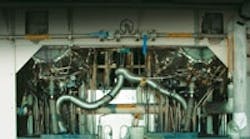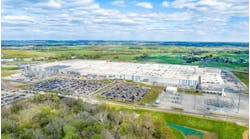"Reduce, reuse and recycle" are the new watchwords for manufacturing managers looking to set a new standard for manufacturing excellence. And just like any other improvement idea, there are benefits to being the first, and the best, at implementing it.
Take Subaru of Indiana (SIA). The automotive facility manufactures a number of different models for Subaru's North American marketing effort, as well as manufacturing the Camry under a production partnership with Toyota.
Perhaps the most remarkable thing about this altogether remarkable plant is its achievement of zero -- specifically, zero landfill waste. According to safety and environmental compliance manager Denise Coogan, Subaru of Indiana didn't start out with zero even as a stretch goal, but a series of small improvements over time has enabled the team to achieve it nonetheless.
With all the "green spin" these days, this flavor of zero is all the more noteworthy in that SIA management didn't change the goalposts to meet the goal. "We didn't redefine 'zero'," she says. "Zero means zero. Nothing from our manufacturing process goes to the landfill."
With great claims come great responsibility, and precisely because these aggressive zero-waste claims leave SIA open to criticism, Coogan says the company is adamant in taking pains to ensure that all is as it should be in its waste stream. "We audit our partners ourselves personally, to make sure they are doing what they say they're doing with our product," she says. "We wouldn't want to find this stuff out in a field somewhere."
| Subaru's Reverse Supply Chain | |
| In 2007 alone, one Subaru plant recycled: | Thereby conserving: |
| 13,142 tons of steel | 29,200 mature trees |
| 1,448 tons of cardboard and paper | 670,000 gallons of oil |
| 194 tons of various plastics and foams | 34,700 gallons of gasoline |
| 20 tons of pop cans and bottles | 10,136,000 gallons of water |
| 10 tons of solvent-soaked rags | 53,116,000 KwH of electricity |
| 4 tons of light bulbs | 34,500 cubic yards of landfill airspace |
For instance, setting stretch goals has spurred innovative responses from the shop floor on up in initiatives devised by sharp-thinking employees. "Our stamping associates were looking to meet their targets, and discovered that every roll of steel that we blanked out had 3' 9" left, when we needed 4 feet to stamp out a hood," Coogan notes. "So our associates worked with our supplier and specified a more exact amount, and we found that by changing this little thing, we saved 102 pounds of steel for every car that we build."
The savings realized by this simple step extend far beyond the obvious elimination of scrap. "It saves raw materials that we haven't had to buy, and that we don't have to ship those extra few feet of scrap, and have to recycle it -- it's not much on the face of it, but it adds up," she says.
This team effort complements a program of intense cooperation with SIA's suppliers (for instance, encouraging investment in reusable containers and recyclable packaging materials), 81% of whom are ISO 14001 certified. By specifying the use of recyclable shipping materials, Coogan says the company benefits from a more efficiently designed process that saves money and time, as well as other precious resources.
Cradle to Ladle
One main ally in SIA's fight against the garbage man is a "byproduct placement" company called Allegiant Global Services that performs three basic functions: on-site collection and sorting of recyclable materials, advice on using recyclable and reusable materials, and creation of markets for manufacturing byproducts. "We're in the car making business, not the waste management business," Coogan says. "Allegiant finds us places to recycle our material."
The partnership between Allegiant and SIA forms an interesting example of the new kind of closed-loop system that is being forged by today's progressive manufacturers.
Once this "dry still bottom" material heads out the door, it gets treated one more time and even the eventual byproduct of the byproduct finds a use. "A distiller fractions out all the organic material and sells that off, then the char that remains gets sent to a steel mill, where it is used as a non-stick coating for steel ladles," relates Coogan. The end of this long story? A formerly hazardous manufacturing byproduct finds value downstream, eventually ending up at an upstream supplier for SIA -- a closed loop indeed.
No doubt turning its waste stream into a profit center helps ease the pain of so much effort. It helps that at SIA, management is fully committed to carrying through on tough goals. However, even the best intentions will only get you so far, and in SIA's case, Coogan notes that their accountability program is tied to environmental performance, adding incentive to enthusiasm. "Every year we all get together and set targets to determine what our goals will be," she says. "Up to 10% of managers' gross annual pay can be dependent on making those targets."
Green Pilots
Stretch goals and accountability at the individual plant level become even more important when applied across multisite, global manufacturers such as Cleveland, Ohio-based Eaton Corp. Often, the question isn't, "When to start?" but instead, "Where?" and "How much?" to apply the "reduce, recycle, reuse" methodology.
"We've set a company-wide goal of 3% reduction each year, with a total of 18% reduction through by 2012," says Dave Davidson, solutions center manager at Eaton's Sumter, S.C., electronic equipment manufacturing facility. "In order to meet these goals as a company, we've got to have each facility reduce its emissions by at least that much."
According to Eaton's plan, the criteria for projects chosen for road testing at Sumter are generality of application -- that is, they are able to be implemented across a large segment of Eaton's facility base -- and that they work, of course. Davidson says that it's all really just common sense.
"We're trying to pick strategies right now that are very common among facilities, and then we're expecting that other facilities with unique needs will come up with unique solutions," he notes. "Some will work everywhere, but some -- especially renewable energy projects, where maybe wind will work at one facility and solar at another -- are specific to the location or even the product mix. We're deploying some of these strategies in parallel, some of which we've already implemented in the Sumter facility, and we know what the results are.
"We're not looking to make every facility carbon-neutral," he adds, "but the point is every time we look at a project, we're not necessarily looking at how to do it once in one place, but how to sustain whatever benefit we get over time in many places."
The program suggestions are coming fast and furious, both from within the beta site in Sumter and also from around the company. "On our docket there are 60 potential projects. We've implemented nine of them so far, and are working diligently to get the rest evaluated, analyzed and possibly started up and deployed," Davidson reports. "Our goal is to get to a carbon-neutral manufacturing facility without purchasing offsets."
Sustainability Teams
For Eaton, the process of getting to zero began with a robust educational program designed to validate the goal in the eyes of the workforce. It wasn't hard, Davidson says. "After we did a training program, we held an employee pledge day, and we had 600 employees lined up at the counters pledging their help."
With its commitment to reduce impact in place, the obvious culprits came first. "The sustainability team started by upgrading the HVAC controls system," remembers Davidson. "Then we installed a lighting control system, to take advantage of ambient lighting and daylighting, to help reduce our demand off the grid."
Like at SIA, the paint room provided a lot of room for reductions. "We took a look at our paint processes, and changed the chemical composition so that our paint will cure at a lower temperature. We now use a lot less natural gas, and we've also been able to reduce the amount of water necessary by 50%. Now all that water isn't being sent to the wastewater treatment plant, and the energy that isn't being used to treat the water results in even more of a reduction in carbon emissions," says Davidson.
Next under scrutiny came the air compressors -- another point of waste for many plants. "We installed automated controls on our compressed air on our assembly lines, so that whenever possible, the compressed air supply shuts off at the hard line so you won't have compressors coming online to keep pressure at 3 a.m.," he says. "A lot of this stuff, we look at and say, 'Why weren't we doing this before?'"
Even the facility's parking lots are getting greened. "We're replacing our parking lot lighting with LED fixtures, which will save energy and maintenance since LED lamps last so long." The Sumter facility also plans to power its parking lot lights (among other solar pilots) with PV panels, so the lights at night are powered by the light of day.
Another parking lot improvement was behaviorally oriented -- the Sumter management team reassigned the parking lot spaces to favor high-mileage (45 mpg or above) and high-occupancy vehicles instead of high-ranking company officials.
These are just a few of the many pilot tests under way at Sumter, but more than a set of individual initiatives. Davidson says the net result the Eaton facility is aiming for is nothing less than a different, better vision of what a manufacturing plant can be. "All of these initiatives dovetail together and make each other easier," he says. "Each one helps us understand that a larger idea, like design for sustainability, can be accomplished."
Grid-Free Zone
Back in 1999, the decision-makers at snack food manufacturer Frito-Lay faced a decision -- to keep their energy management internally, or outsource it to an energy provider. They decided to keep it in-house, a decision that energy and utilities manager Al Halvorsen says averted a disaster. "We actually almost signed a contract with Enron," he remembers. "The decision to develop the competency internally was a turning point for us."
To ensure a top-quality energy management and reduction effort, Frito-Lay formed a high-level group (called the Frito Lay Department of Energy) to push efficiency initiatives throughout the organization. Halvorsen says that this cross-functional team has been instrumental in allowing Frito-Lay to aim for a truly audacious goal of "net zero," employing a robust program of energy and water use reduction and alternative energy systems implementation to go completely off the power and water grid. The company even went so far as to hire the National Renewable Energy Laboratory to take a look at its plants and map the best alternative energy sources for each, and chose its Casa Grande plant as the pilot site for the net zero effort.
In answering the question, "How do you green your operations?", Halvorsen echoes the employee engagement sentiment expressed by his colleagues at other companies, and compares the green goodwill to an alternative energy source waiting to be tapped. "Sustainable change cannot and will not be just a headquarters-led operation," he says. "The energy and enthusiasm are there. Your people want to be doing these things; you just have to ask."
For more information on how other leading manufacturers such as 3M, Steelcase, Stonyfield Farms, Interface are setting and achieving their environmental goals, visit IW's Green Spot microsite at www.industryweek.com/greenspot.




